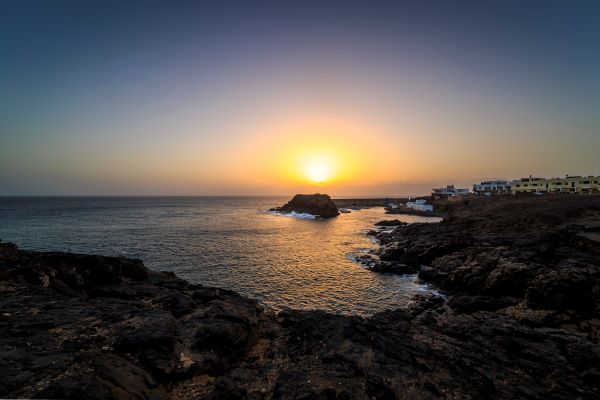An endless coastline, surreal landscapes and simple natural beauty…Fuerteventura has so much to offer. Discover the best things to see and do on this enchanting island.
Fuerteventura is a special destination and a favorite of surfers, nature lovers and travel enthusiasts. Here you can combine the sea, relaxation, cultural visits and unforgettable adventures, with something suitable for the whole family.
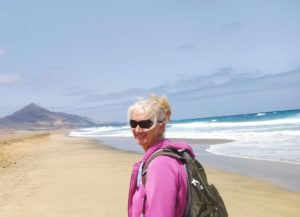 To discover this island at its best and experience it like a local, we interviewed Sally Barton, Team Leader at the TUI Magic Life resort in the south of Fuerteventura. Sally is originally from the UK and first visited this Canary gem 20 years ago during a family vacation. She immediately fell in love with the peace and serenity of the place, its rugged mountain landscapes, beaches and the creative energy emanating from its natural beauty.
To discover this island at its best and experience it like a local, we interviewed Sally Barton, Team Leader at the TUI Magic Life resort in the south of Fuerteventura. Sally is originally from the UK and first visited this Canary gem 20 years ago during a family vacation. She immediately fell in love with the peace and serenity of the place, its rugged mountain landscapes, beaches and the creative energy emanating from its natural beauty.
Below you’ll find all her top tips and secret insights about Fuerteventura. Discover what to visit, where to eat, must-see events and much more.
The best things to do in Fuerteventura
What to visit in Fuerteventura
- Betancuria: Make a stop here to discover the history of Fuerteventura and the Canary Islands. Once the ancient political and administrative center of the island, today it’s a charming traditional village with a beautiful cathedral, fascinating archaeological museum, cobbled streets, craft shops and numerous tapas restaurants. On the way to Antigua, Sally recommends a stop at the Mirador Morro Velosa, where you can admire a truly extraordinary panorama. If you’re short on time, a good idea is to take a tour of the highlights of Fuerteventura, which combines a stop at Betancuria with a tasting of local products and a visit to an aloe vera farm.
- Ajuy: On the west coast of the island lies the sleepy village of Ajuy, which comes to life when tourists visit to see the famous natural caves. Starting from the black sand beach, walk up the cliff until you reach the caves. Along the way, you’ll find curious sand formations, formed by the wind over the years. A tour of Ajuy and Las Peñitas, will give you the complete experience.
- Cofete: The wild coast of Cofete is accessible only by public bus (which passes twice a day), rental 4×4 jeeps, or official excursions. Cofete is located in the Jandia natural park and is a very small village with a restaurant serving up tapas. Even the road to get there is worth the trip and has truly exceptional views. In addition, at certain times of the year, turtles are released into their natural habitat.
- A goat farm: Discover the unique flavor of the island by tasting its internationally renowned cheeses. You’ll also get to learn about the production process and try other local products on a visit to a goat farm. Sally recommends this experience to get to know an essential side of the island’s culture.
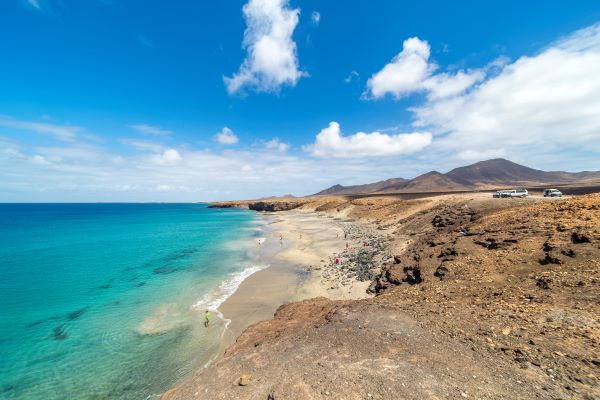
The best beaches in Fuerteventura
Fuerteventura is famous for its varied coastline, with beaches of pebbles or black and gold sand. Sally invites you to take the car and look around: there’s always a tucked-away beach waiting to be discovered. Take some time and you’re sure to find a beach where you can escape the rest of the world and enjoy the extraordinary energy and atmosphere of the island.
Below are some of the most famous beaches:
- Playa de Sotavento: A beautiful golden sand beach on the southeast coast, it also happens to be the location for the Windsurfing World Championship held every year. Thanks to the warm temperatures all year round, this beach is perfect for all seasons. Take a dip in the water and join the Windsurf, Kitesurf, and Foil enthusiasts, or, for a more relaxing experience, dedicate yourself to standup paddleboarding (SUP).
- El Cotillo: Located in the northwestern part of Fuerteventura, El Cotillo’s rugged and tranquil coast is breathtaking. The presence of the lagoons makes it safe for even the little ones to swim, while the older children can explore marine life in the rock pools. The northern part instead is a paradise for surfers. It’s also lovely to walk around the small port with traditional fishing boats.
- Snorkeling: Whichever beach you choose, take some time to discover the underwater life of the island. You’ll see many different fish species in the waters around the island, and if you’re lucky, you might also spot a ray. Off the southeast coast, you can also see dolphins. Bring the necessary equipment and dive into your aquatic adventure.
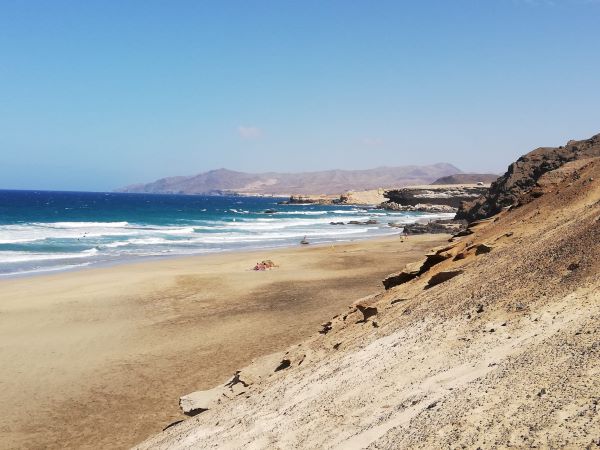
Must-see panoramic views in Fuerteventura
The sunrises and sunsets here are spectacular, and Sally reveals some truly special places to enjoy them. La Pared, on the southwest coast, and El Cotillo, on the northwest coast, are ideal locations to watch the sun disappear over the horizon. Sunrise, on the other hand, can be admired from the Corralejo dune natural park on the northeast coast, or from any of the small fishing villages on the southeast coast.
Thanks to the island’s formation, consisting of mountain ranges and cliffs, there are many viewpoints from which you can enjoy a spectacular view. Wherever you go, take the time to stop by the roadside and admire the colors and shapes of the mountains.
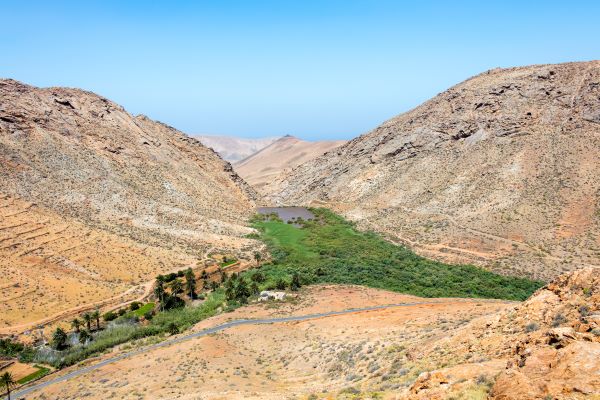
Eating in Fuerteventura: Canary Island dishes to try
Just like Sally, we think that tasting the local cuisine is essential on any trip. Her first tip is to taste the goat cheese of Fuerteventura, available in different varieties: fresh, aged, or semi-aged. In many bars and restaurants, you’ll find it on the menu in the form of tapas or sides.
Secondly, try some of the local tapas, such as fried goat cheese with jam, which Sally describes as “a perfect balance between sweet and salty that melts in your mouth”.
If you’re looking for more substantial fare, choose goat meat stew (carne de cabra, a typical dish of the island. The meat, usually of local origin, is cooked for about three hours with vegetables and potatoes, with wonderfully tasty results. There’s also a fish-based version, often served with gofio (corn flour) mixed with the stew’s gravy and raw onion marinated in vinegar. It may seem like an unusual combination, but together they create a delicious harmony of flavors.
At the end of the dinner, they’ll probably offer you a glass of Ron Miel, the typical honey rum of the Canary Islands. It’s a sweet liquor that should be drunk in one go. Sometimes it’s also served topped with a bit of cream. Ultimately, Sally’s advice around eating is “Be adventurous and discover the flavors of our island”.
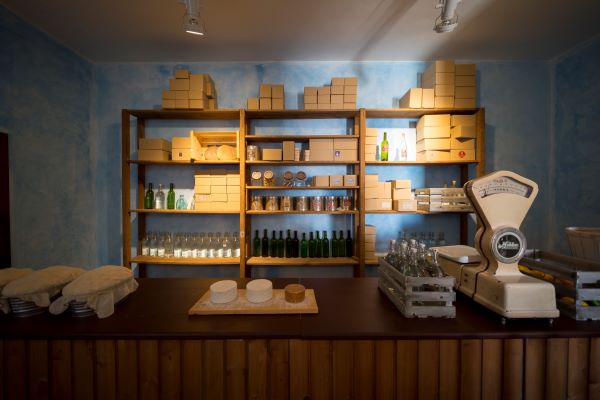
The best time to visit Fuerteventura
Fuerteventura is a perfect destination all year round. Even in January, the sun shines and temperatures can reach up to 77°F (25°C). However, the evenings do get cooler, especially between December and March, so we recommend bringing a sweater or jacket.
Additionally, Sally says, “In the months of July, August, and September, the island is very crowded”. But not to worry, even if you’re there during peak season, you can always find a beach to yourself.
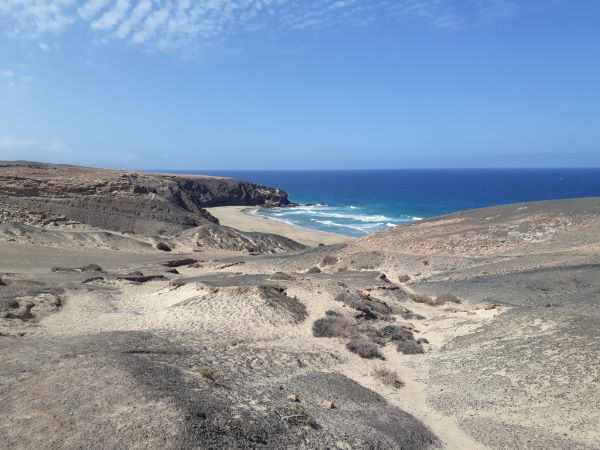
Festivities not to be missed
Fuerteventura is full of small towns, each of which has a patron saint that’s celebrated with a traditional festival. During these festivals, you can immerse yourself in the local culture, listen to traditional music and dance to a live band. You’ll only need to know a few words of Spanish to order food and drinks at the stalls. The celebration ends with a mass in honor of the saint, followed by a procession through the town streets. These events take place throughout the year, so whatever period you visit, you’ll be able join in the fun of a festival.
Carnival, held in February or March, is a particularly big event and an opportunity to see locals dressed in all kinds of colorful costumes. Each year there’s a different theme, and in the capital, Puerto del Rosario, celebrations take place not only on land but also at sea. Friends gather to build engine-less boats and compete in a race from the port to the beach.
Practical tips for your vacation in Fuerteventura
- Beware of tides and currents: Sea currents can be very strong, so always pay attention to the signal flags on the beaches and swim only in safe areas.
- Restaurant tips: It’s not obligatory, but if you receive good service you’re more than welcome to leave a tip. Some restaurants include it directly in the bill, so always check.
- Clothing for churches: Always cover your shoulders when entering a place of worship as a sign of respect. This rule applies almost everywhere.
- Public transport: There is a bus service, but schedules aren’t always reliable. If you decide to take a bus, be aware that they only accept cash payments and that rides are not frequent. If you prefer, you can take a taxi; book at your hotel’s reception or look for them at their designated stations. Taxis accept both cash and credit cards.
- Currency exchange for British tourists: Hotels do not change pounds; in which case it’s always better to bring some euros in cash. Most shops and restaurants accept both cards and cash.
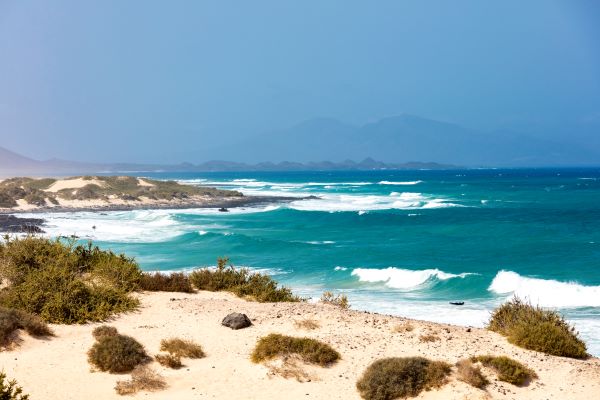
A perfect day in Fuerteventura: More than a beach destination
According to Sally, many visitors don’t know the true beauty of the island and its unique atmosphere. Fuerteventura, also known as “the island of wind”, is much less crowded than Gran Canaria and Tenerife, and offers everything you could wish for.
“Fuerteventura recharges your energy. Every day you can travel the same road through the mountains, but the colors keep changing: red, brown, burgundy… it’s spectacular. If you’re looking for a place to disconnect from routine, Fuerteventura will make you feel alive and fill you with positivity. It’s a perfect retreat.”
We asked Sally to describe the ideal day on the island, and she said it should start with a visit to the Mirador de Morro Velosa, a viewpoint from which you can admire the vast unspoiled landscapes. Then follow it up with Betancuria, the ancient capital, for a relaxing lunch. In the afternoon, a swim in the crystal-clear waters of Los Molinos beach is essential. Finally, end the day beautifully with dinner in a traditional restaurant at a small village, where you can savor the local dishes of Fuerteventura.
Sally also emphasizes that the island is around 100km long, so it’s impossible to discover it all in one day. Her advice is to divide it into three zones – north, center, and south – and explore it at your leisure, even if this means having to come back several times…
